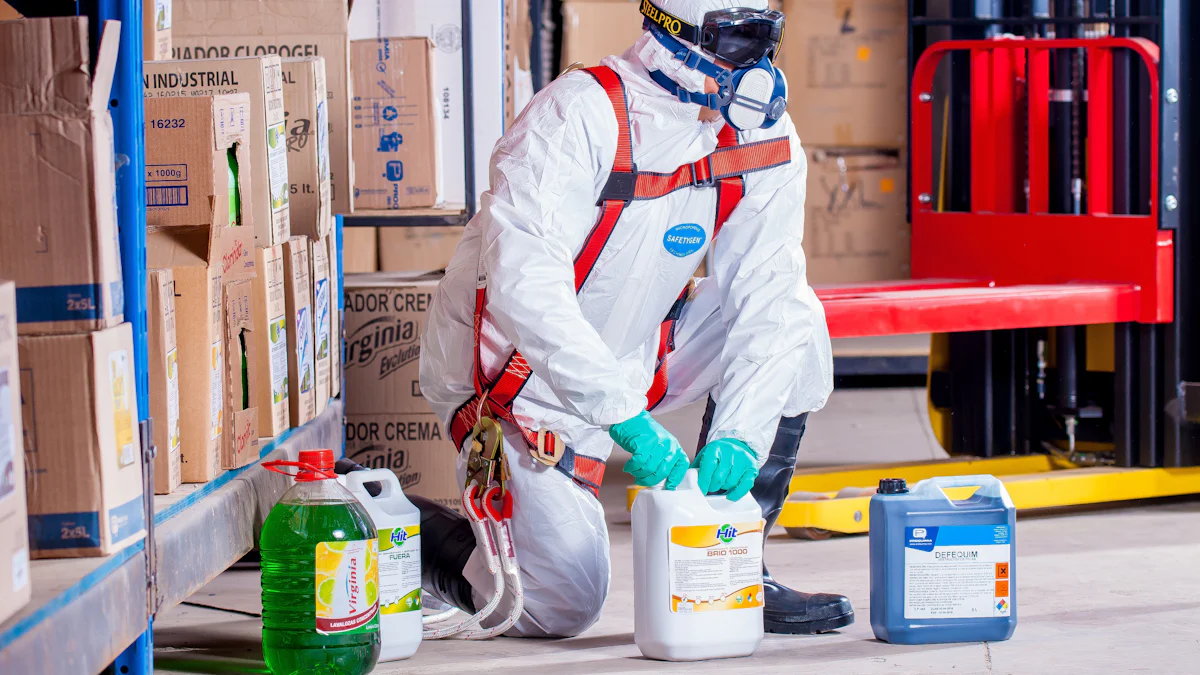
Chemical spills can happen unexpectedly, and they bring serious risks. Harmful substances may cause burns, respiratory problems, or even poisoning. Some spills, like biological ones, might carry pathogens that lead to disease. A chemical spill kit helps you handle these emergencies safely. These kits include tools for spill clean-up and protect you from exposure. Having one ensures you’re prepared with a proper spill response plan and spill response procedures.
Key Takeaways
A chemical spill kit is important for keeping workplaces safe. It has tools and safety gear to clean spills fast and keep workers safe.
Check and refill your spill kit often. Monthly checks make sure everything is there and works well, so you’re ready for emergencies.
Teach workers how to use the spill kit properly. Practice helps them feel ready and act quickly and safely during spills.
What Are the Spill Kit Contents of a Chemical Spill?

When dealing with hazardous spills, having the right tools on hand can make all the difference. A chemical spill kit contains essential components designed to help you respond quickly and effectively. Let’s break down what you’ll typically find inside.
Absorbent Pads, Socks, and Pillows
Absorbent materials are the backbone of any spill kit. Pads are perfect for soaking up small spills quickly. Socks act as barriers, preventing liquids from spreading further. Pillows handle larger spills or persistent leaks, especially in tricky spots like under machinery. These items are made from materials that absorb specific chemicals, ensuring efficient cleanup. Whether it’s a general purpose spill kit or a hazchem spill kit, these absorbents are indispensable.
Personal Protective Equipment (PPE)
Your safety comes first. That’s why spill kits include personal protective equipment like gloves, goggles, and sometimes respirators. These items shield you from harmful substances during cleanup. For example, gloves protect your hands from corrosive chemicals, while goggles keep your eyes safe from splashes. PPE is a must-have in any spill response plan.
Neutralizing Agents for Specific Chemicals
Some spill kits, like a hazchem spill kit, include neutralizing agents tailored to certain chemicals. For instance, sodium bicarbonate neutralizes acids, while calcium carbonate adjusts pH levels in wastewater. These agents help you safely manage spills by reducing their hazardous properties.
Disposal Bags and Containers
Once the spill is contained, you’ll need to dispose of the waste properly. Heavy-duty disposal bags are included in most kits to handle hazardous materials. These bags ensure that contaminated items, like used absorbents and PPE, are safely removed without risking further exposure.
Instruction Manual or Guide
Every spill kit comes with a guide to walk you through the cleanup process. It explains how to use the kit’s contents effectively and safely. This manual is especially helpful if you’re dealing with different types of spill kits, such as a fuel and oil spill kit or a general purpose spill kit.
By understanding these essential components, you’ll be better prepared to handle chemical spills and protect yourself, your team, and the environment.
Why Is a Chemical Spill Kit Important?
Ensures Workplace Safety
When a chemical spill happens, your first priority is keeping everyone safe. Spill kits give you the tools to act fast and protect employees from harm. They include personal protective equipment (PPE) like gloves and goggles, which shield you from dangerous substances. With these kits, you can minimize exposure to harmful chemicals and prevent injuries. Having a spill kit on hand also empowers your team to respond confidently and safely during emergencies. It’s not just about cleanup—it’s about creating a safer workplace for everyone.
Protects the Environment
Chemical spills don’t just affect your workplace—they can harm the environment too. Without proper containment, chemicals can seep into the soil, pollute water sources, and even damage marine ecosystems. Spill kits help you stop these disasters before they happen. They contain absorbent materials and disposal bags that let you clean up spills quickly and responsibly. By using a spill kit, you’re not only protecting nature but also showing your commitment to environmental responsibility.
Helps Meet Regulatory Compliance
Regulations like OSHA and HAZWOPER require workplaces to prepare for hazardous spills. Spill kits make it easier for you to meet these standards. They provide the tools you need to handle spills safely and efficiently, which helps you avoid fines and penalties. Stocking spill kits also shows that you’re serious about maintaining a hazard-free workplace. It’s a simple step that keeps you compliant and protects your employees at the same time.
Reduces Downtime and Cleanup Costs
Spills can disrupt your operations and cost you money. But with a spill kit, you can clean up quickly and get back to work. These kits come with absorbent pads, disposal bags, and other tools that streamline the cleanup process. Acting fast prevents damage to equipment and facilities, saving you from expensive repairs. Plus, minimizing downtime means you can keep your business running smoothly. Investing in spill kits is a smart way to save time and money in the long run.
Best Practices for Using and Maintaining a Spill Kit

Proper Storage and Accessibility
Storing spill kits properly ensures they’re ready when you need them most. Place them in easily accessible locations, especially near areas where chemical spills are likely to occur. Avoid cluttered or hard-to-reach spots that could delay your response. Brightly colored containers can make the kits more visible, helping you locate them quickly during emergencies. Think about the size of your workspace and the risks involved when deciding where to store them. Keeping spill kits within arm’s reach of high-risk zones can save valuable time and minimize damage.
Regular Inspections and Restocking
A spill kit is only useful if it’s fully stocked and in good condition. Regular inspections are key to ensuring everything is ready to go. Check for missing or damaged components, like absorbent pads or personal protective equipment. Replace any used or expired items immediately. Set a schedule for these inspections—monthly checks work well for most workplaces. By staying on top of maintenance, you’ll avoid unpleasant surprises when a spill happens.
Employee Training on Spill Kit Usage
Employee training is essential for effective spill response. Make sure your team knows how to use the kits and understands the hazards of different chemicals. Training should include hands-on practice, like containing spills and selecting the right PPE. Teach employees how to identify the components of the kit and follow emergency procedures. Simulating real-life spill scenarios can boost confidence and prepare your team for the unexpected. A well-trained team can handle spills safely and efficiently, protecting everyone involved.
Understanding the Types of Spills It Can Handle
Not all spill kits are created equal. Some are designed for general-purpose spills, while others target specific chemicals like acids or solvents. Before a spill occurs, familiarize yourself with the types of spills your kit can handle. For example, a hazchem spill kit might include neutralizing agents for acids, but it won’t work for oil-based spills. Choosing the right kit for your workplace ensures you’re prepared for the hazards you’re most likely to face. Always match the kit to the chemicals you use to avoid complications during cleanup.
A chemical spill kit is more than just a safety tool—it’s an investment in your workplace’s future. These kits let you respond quickly to spills, keeping your team safe and preventing environmental damage. Proper storage and regular maintenance ensure they’re always ready when you need them. By training your employees, you create a culture of safety and preparedness. Choosing high-quality kits, like those from UPQUARK, shows your commitment to compliance and employee well-being. Protecting people, property, and the environment starts with being prepared.
FAQ
What types of chemical spill kits does UPQUARK offer?
UPQUARK provides general-purpose, hazchem, and oil spill kits. Each kit is tailored to specific spill types, ensuring you’re prepared for any workplace emergency.
How often should I inspect my spill kit?
Check your spill kit monthly. Look for missing or damaged items and replace them immediately. Regular inspections keep your kit ready for unexpected spills.
Can I reuse absorbent materials from a spill kit?
No, absorbent materials are single-use. Dispose of them properly after cleaning up a spill to avoid contamination or safety risks.
💡 Tip: Always restock your UPQUARK spill kit after use to stay prepared for future emergencies.
See Also
Evaluating UPQUARK Marine Absorbents for Effective Oil Cleanup
Practical Uses of Oil Absorbent Socks Explained

